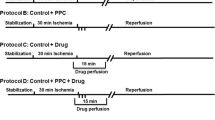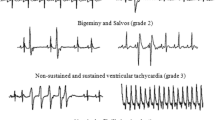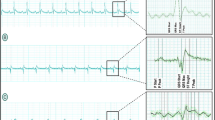Summary
It has been reported that agents having the ability to scavenge oxygen-derived free radicals reduce the severity of ventricular arrhythmias that occur after brief coronary occlusion and reperfusion. Superoxide dismutase plus catalase (SOD + CAT) or placebo was administered in a blinded randomized fashion prior to coronary occlusion in rats (n = 25 each group) undergoing a 5-min left coronary occlusion followed by 15 min of reperfusion. During reperfusion, ventricular tachycardia (VT) developed in 96 % of animals in both groups. Reperfusion ventricular fibrillation (VF) developed in 60 % of the placebo group vs 56 % in the SOD + CAT group (p =1.0). Irreversible VF occurred in 40 of the placebo group vs 20 % in the SOD + CAT group (p = 0.22). Atrioventricular block occurred in 12 % of placebo and 4 % of SOD + CAT animals (p = 0.61).
There were no significant differences between groups in duration of VT (85 ± 15 s (mean ± SEM) placebo vs 81 ± 14 s SOD + CAT, p = 0.81), total duration of VT plus VF (391 ± 76 s placebo vs 256 ± 64 SOD + CAT, p = 0.45) or numbers of single ventricular ectopic beats (65 ± 15 placebo vs 97 ± 18 SOD + CAT, p = 0.18). Heart rate at reperfusion was slightly higher in control than SOD + CAT animals (340 ± 33 vs 319 ± 32, p = 0.02). Risk zone size, determined by Monastral blue injection, was equal in both groups (34 ± 2 % of ventricular mass). The occurrence of reperfusion VF in this model could not be predicted by heart rate at reperfusion (331 ± 33 VF animals vs 328 ± 36 no VF, p = 0.77), or by risk zone size (34 ± 2 %, VF and no VF groups).
Treatment with SOD + CAT did not reduce the overall incidence or duration of reperfusion arrhythmias in this model, though such treatment was associated with a non-significant trend toward less irreversibility of VF.
Similar content being viewed by others
References
Manning AS, Hearse DJ (1984) Reperfusion induced arrhythmias: Mechanisms and prevention. J Mol Cell Cardiol 16:497–518
Ferrier GR, Moffat MP, Lukas A (1985) Possible mechanisms of ventricular arrhythmias elicited by ischemia followed by reperfusion. Circ Res 56:184–194
Zweier JL, Flaherty JT, Weisfeldt ML (1987) Direct measurement of free radical generation following reperfusion of ischemic myocardium. Proc Natl Acad Sci 84:1404–1407
Przyklenk K, Kloner RA (1986) Superoxide dismutase plus catalase improve contractile function in the canine model of the “stunned myocardium”. Circ Res 58:148–156
Przyklenk K, Kloner RA (1989) “Reperfusion injury” by oxygen-derived free radicals? Effect of superoxide dismutase plus catalase, given at the time of reperfusion, on myocardial infarct size, contractile function, coronary microvasculature, and regional myocardial blood flow. Circ Res 64:86–96
Jolly SR, Kane WJ, Bailie MB, Abrams GD, Luchessi BR (1984) Canine myocardial reperfusion injury: Its reduction by the combined administration of superoxide dismutase and catalase. Circ Res 54:277–285
Bernier M, Hearse DJ, Manning AS (1986) Reperfusion-induced arrhythmias and oxygen-derived free radicals. Circ Res 58:331–340
Woodward B, Zakaria MNM (1985) Effect of some free radical scavengers on reperfusion induced arrhythmias in the isolated rat heart. J Mol Cell Cardiol 17:485–493
Manning AS, Bernier M, Crome T, Little S, Hearse D (1988) Reperfusion-induced arrhythmias: a study of the role of xanthine oxidase-derived free radicals in the rat heart. J Mol Cell Cardiol 20:35–45
Hale SL, Vivaldi MT, Kloner RA (1986) Fluorescent microspheres: a new tool for visualization of ischemic myocardium in rats. Am J Physiol 251:H863–H868
Walker MJ, Curtis MJ, Hearse DJ, et al (1988) The Lambeth conventions: guidelines for the study of arrhythmias in ischemia, infarction, and reperfusion. Cardiovasc Res 22:447–455
Riva E, Manning AS, Hearse DJ (1987) Superoxide dismutase and the reduction of reperfusioninduced arrhythmias: in vivo dose-response studies in the rat. CV Drugs Ther 1:133–139
Prasad K, Kalra J, Buchko G (1988) Acute hemorrhage and oxygen free radicals. Angiology 39:1005–1013
Bernier M, Curtis MJ, Hearse DJ (1989) Ischemia-induced and reperfusion-induced arrhythmias: importance of heart rate. Am J Physiol 256:H21–31
Hearse DJ, Kusama Y, Bernier M (1989) Rapid electrophysiologic changes leading to arrhythmias in the aerobic rat heart. Photosensitization studies with rose bengal-derived reactive oxygen intermediates. Circ Res 65:146–153
Bernier M, Manning AS, Hearse DJ (1989) Reperfusion arrhythmias: dose-related protection by anti-free radical interventions. Am J Physiol 256:H1344–1352
Coetzee WA, Owen P, Dennis SC, Saman S, Opie LH (1990) Reperfusion damage: free radicals mediate delayed membrane changes rather than early ventricular arrhythmias. Cardiovasc Res 24:156–164
Heuer HJ, Muller E, Bernauer W (1988) Differential effects of superoxide dismutase on high energy phosphates, creatine kinase release, and arrhythmias during post-ischaemic reperfusion in isolated rat hearts. Basic Res Cardiol 83:149–157
Hearse DJ, Tosaki A (1987) Free radicals and reperfusion-induced arrhythmias: protection by spin trap agent PBN in the rat heart. Circ Res 60:375–383
Parratt JR, Wainwright CL (1987) Failure of allopurinol and a spin trapping agent N-t-butyl-alphaphenyl nitrone to modify significantly ischaemia and reperfusion arrhythmias. Br J Pharm 91:49–59
Klein HH, Pich S, Lindert S, Buchwald A, Nebendahl K, Kreuzer H (1988) Intracoronary superoxide dismutase for the treatment of “reperfusion injury”. A blind randomized placebocontrolled trial in ischemic, reperfused porcine hearts. Basic Res Cardiol 83:141–148
Euler DE (1989) The effect of free radical scavengers on canine reperfusion arrhythmias. Circulation 80:11–30
Magovern GJ Jr, Bolling SF, Casale AS, Bulkley BH, Gardner TJ (1984) The mechanism of mannitol in reducing ischemic injury: hyperosmolarity or hydroxyl scavenger? Circulation 70:91–95
Vander Heide RS, Sobotka PA, Ganote CE (1987) Effects of the free radical scavenger DMTU and mannitol on the oxygen paradox in perfused rat hearts. J Mol Cell Cardiol 19:615–625
Barrington PL, Meier CF, Weglicki WB (1988) Abnormal electrical activity induced by free radical generating systems in isolated cardiocytes. J Mol Cell Cardiol 20:1163–1178
Palladini RT, Perry MA, Campbell TJ (1987) Proarrhythmic effects of an oxygen-derived free radical generating system on action potentials recorded from guinea pig ventricular myocardium: a possible cause of reperfusion-induced arrhythmias. Circ Res 61:50–54
Dennis SC, Coetzee WA, Yon E, Opie LH (1985) Failure of free oxygen radicals to alter cardiac action potential and reoxygenation automaticity. Circulation 72:111–228
Rosenthal JE, Brown RL (1988) Electrophysiological effects of anti-free radical interventions in canine Purkinje fibers. J Mol Cell Cardiol 20:1053–1067
Kramer JH, Arroyo CM, Dickens BF, Weglicki WB (1987) Spin-trapping evidence that graded myocardial ischemia alters post-ischemic superoxide production. Free Rad Biol Med 3:153–159
Maupoil V, Rochette L (1988) Evaluation of free radical and lipid peroxide formation during global ischaemia and reperfusion in isolated perfused rat heart. Cardiovasc Drugs Ther 2:601–607
Corr PB, Pogwizd SM (1988) Mechanisms contributing to arrhythmogenesis during early myocardial ischemia, subsequent reperfusion, and chronic infarction. Angiology 39:684–699
Belli R, Patel B (1988) Factors that determine the occurrence of reperfusion arrhythmias. Am Heart J 115:20–29
Kaplinski E, Ogawa S, Michelson EL, Dreifus LS (1981) Instantaneous and delayed ventricular arrhythmias after reperfusion of acutely ischemic myocardium: evidence for multiple mechanisms. Circulation 63:333–340
Author information
Authors and Affiliations
Additional information
Supported in part by National Institutes of Health SCOR HL-26215, Bethesda, Maryland 660
Rights and permissions
About this article
Cite this article
Hagar, J.M., Hale, S.L., Ilvento, J.P. et al. Lack of significant effects of superoxide dismutase and catalase on development of reperfusion arrhythmias. Basic Res Cardiol 86, 127–135 (1991). https://doi.org/10.1007/BF02190545
Received:
Issue Date:
DOI: https://doi.org/10.1007/BF02190545




